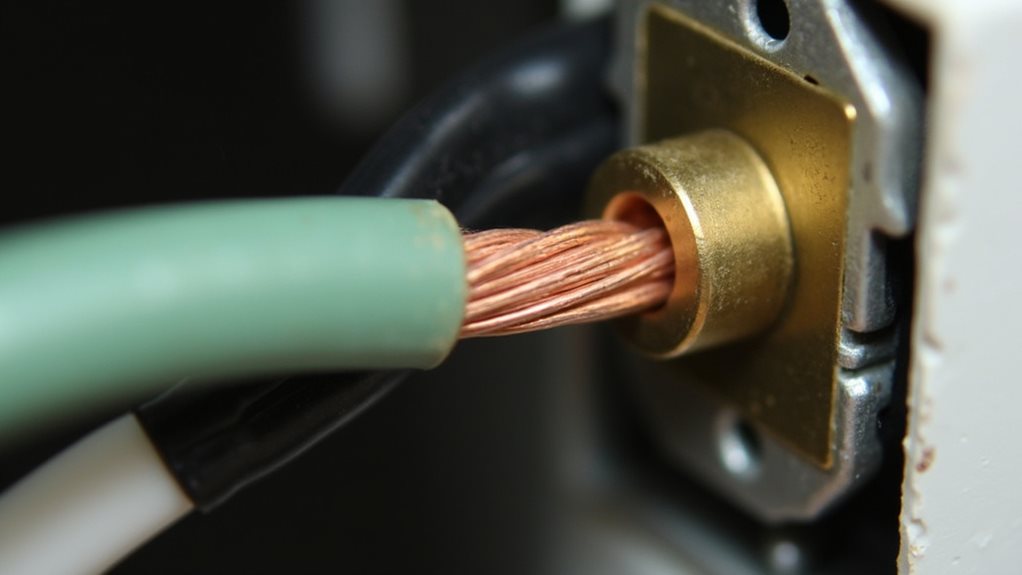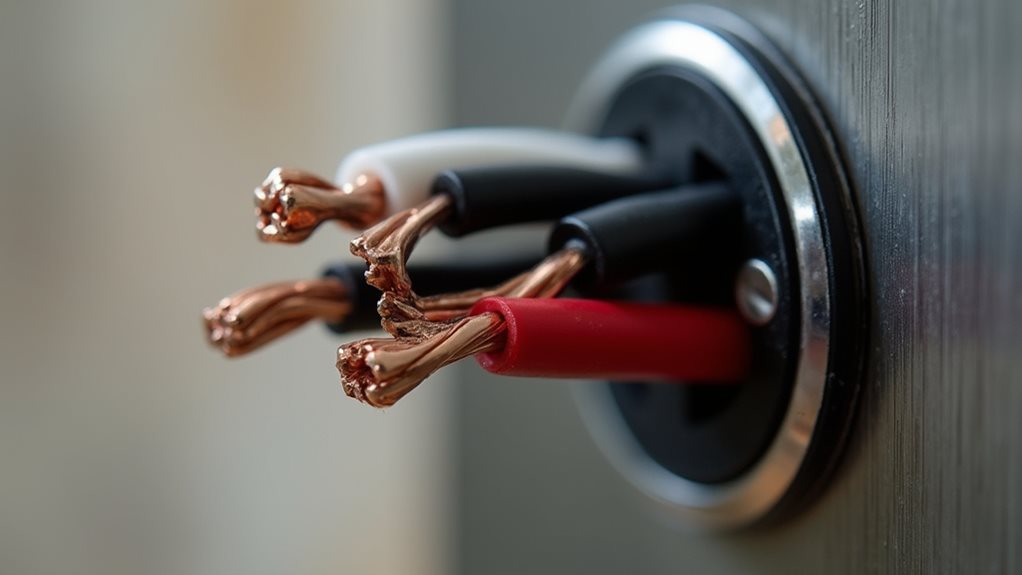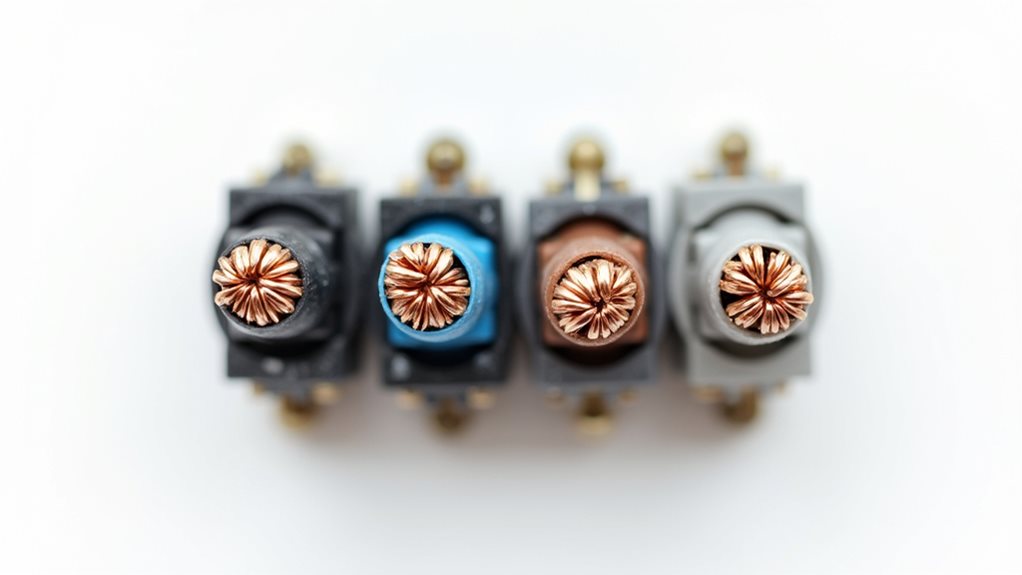On a light switch, you’ll find that the common wire is typically black, connecting to the common terminal that carries power through the circuit. In single-pole switches, this black wire serves as the hot conductor, while in three-way switches, it functions as either the common wire or a traveler. White wires are neutral, and green or bare copper wires handle grounding. Understanding these color codes is essential for safe electrical work, but there’s much more to proper switch wiring than just wire colors.
TLDR
- The common wire on a light switch is typically black, connecting to the common terminal in both single-pole and three-way configurations.
- White wires serve as neutral connections and should be properly identified with electrical tape if used as common wires.
- In three-way switches, the black wire remains the common wire while blue or yellow wires function as travelers.
- Red wires can sometimes serve as common wires in light switches, especially when used as secondary hot conductors.
- Proper identification of the common wire is crucial for safety and should be verified with a voltage detector before installation.
Understanding Common Wire Colors in Light Switches

When you’re working with light switches, understanding wire colors isn’t just helpful—it’s essential for safety and proper functionality.
You’ll typically find black or red wires carrying the power (hot), white wires serving as neutral, and green or bare copper wires for grounding. Black wires are most commonly used in residential light switch installations. The common wire, which is usually colored white or gray, plays a crucial role in completing the electrical circuit.
In three-way switches, you’ll also encounter blue or yellow traveler wires that enable control from multiple locations.
The Role of Black Wires as Common Terminals
Black wires serve as the workhorses of your light switch’s electrical system, carrying power through the circuit and connecting to the common terminal. You’ll typically find these wires acting as hot conductors in single-pole configurations, while in three-way switches, they can function as either common wires or travelers. It’s important to note that wire gauge recommendations can influence the safety and efficiency of your electrical installations. Always treat black wires with caution, as they’re considered live when connected to power. For maximum safety, use a red wire nut when connecting black wires to ensure secure and proper insulation.
Alternative Wire Colors and Their Functions

Although black wires are common in light switch wiring, you’ll encounter various other wire colors that serve distinct purposes in electrical systems.
Red wires often function as secondary hot wires, while blue and yellow wires typically serve as travelers in three-way switches.
White wires usually indicate neutral connections, and green wires are dedicated to grounding for safety purposes. Proper grounding is critical for electrical safety to prevent hazards and circuit failures.
Safety Guidelines for Light Switch Wiring
Before you start working on any light switch wiring, you’ll need essential protective gear including insulated gloves, safety glasses, and rubber-soled shoes to guard against electrical hazards.
You must always test the wires with a voltage detector to confirm there’s no power running through them, even if you’ve turned off the circuit breaker.
Proper wire identification is vital for safety, so take time to label and verify each wire’s function using both a wiring diagram and color codes, ensuring you don’t mix up the common, ground, or hot wires during installation. Additionally, always ensure that propane tanks are closed completely when not in use to prevent any potential hazards.
Essential Personal Protection Equipment
Working with electrical components requires specific personal protective equipment (PPE) to guarantee your safety during light switch installations and repairs.
You’ll need rubber-soled safety shoes, insulated gloves, and protective eyewear to prevent electrical shock and protect against arc flashes.
Don’t forget to wear long-sleeved natural fiber clothing and a hard hat to shield yourself from falling debris and electrical hazards.
Testing Before Working Live
Beyond having the right protective gear, proper testing procedures will keep you safe when handling electrical switches.
You’ll need to turn off power at the circuit breaker and use a voltage tester to confirm there’s no electrical flow.
Always inspect wires and connections for damage, follow established testing protocols, and comply with national safety standards before beginning any work.
Proper Wire Identification Methods
When working with light switch wiring, proper wire identification stands as one of the most critical safety practices you’ll need to master.
You’ll find black wires typically serve as hot wires, while white wires function as neutral. Green wires provide grounding, and red wires often act as secondary hot wires or travelers in three-way switches.
Always verify connections with a voltage tester before proceeding.
Single-Pole Vs Three-Way Switch Common Wires
When working with light switches, you’ll find that the black wire typically serves as the common wire, connecting to the main power source in both single-pole and three-way configurations.
In a single-pole switch, you’ll see a straightforward setup where the black common wire connects between the power source and the light fixture using a single switch location.
Three-way switch setups are more complex, requiring a black common wire at each switch location along with additional traveler wires (usually red and black) that allow you to control the light from two different spots.
Common Wire Basics
Understanding the basics of common wires in light switches starts with recognizing their fundamental differences in single-pole and three-way configurations.
In single-pole switches, you’ll find one black common wire connecting to the power source, while three-way switches employ two common wires, typically black, with additional traveler wires.
You’ll need to identify these correctly and guarantee proper grounding for safe installation.
Three-Way Switch Configurations
The fundamental differences between single-pole and three-way switch configurations become apparent in their common wire setups.
While single-pole switches employ two terminals with clear ON/OFF markings, three-way switches feature three terminals: one common (typically darker-colored) and two traveler screws.
You’ll notice three-way switches lack ON/OFF labels since their operation depends on the circuit’s state through both switch locations.
Regional Differences in Common Wire Colors

Since electrical standards vary considerably worldwide, you’ll find distinct wire color codes across different regions and countries.
In the United States and Canada, you’ll typically encounter black wires for hot connections and white for neutral, while European countries use brown for hot and blue for neutral.
Ground wires are consistently green, green/yellow, or bare copper across most regions.
Final Note
When working with light switches, you’ll find that proper wire identification is essential for both safety and functionality. Remember that black wires typically serve as common terminals in North American installations, though you’ll need to verify local codes for your region’s specific requirements. Always turn off power at the circuit breaker and use a voltage tester before handling any electrical connections, and don’t hesitate to consult a licensed electrician when you’re unsure.